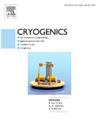Repetitive excitation and demagnetization for magnetic refrigeration using static superconducting coils with trapezoidal wave current generated by resonance and switch operation
IF 2.1
3区 工程技术
Q3 PHYSICS, APPLIED
引用次数: 0
Abstract
Hydrogen has emerged as a promising alternative to fossil fuels due to its key advantage of producing no carbon dioxide during consumption. Liquefaction of hydrogen is recognized as a preferable method for storing substantial quantities. Achieving efficient cooling technology is particularly crucial in the temperature range near 20 K, which aligns with the boiling point of hydrogen. Magnetic refrigeration represents a viable approach to this achievement. Repetitive changes in the magnetic field in magnetocaloric materials are required for magnetic refrigeration and can be obtained using static superconducting coils with trapezoidal wave current.
To efficiently reduce electric power consumption, it was conceived that the trapezoidal wave current could be generated approximately through resonance as alternating current if static superconducting coils were combined with capacitors charged by a power supply. However, the alternating current will inevitably attenuate over time due to circuit resistance.
This study reports a method for modifying the alternating current into the trapezoidal wave current and recovering it to the initial value against attenuation. The method will be beneficial if the residual ratio against the attenuation is accepted to a certain amount. This method consists of a circuit incorporating three switches into a combination of a static superconducting coil and a capacitor with a power supply. By toggling these switches when the alternating current due to resonance reaches its maximum or zero, the alternating current is converted into a trapezoidal wave current and restored to its initial value against attenuation.
A practical case of the method was simulated using analytic software “LTspice.” A small-scale case of the method was experimented and subsidiarily simulated using a palm-sized REBCO coil in liquid nitrogen and an electric double-layer capacitor in the atmosphere. Consequently, the trapezoidal wave current by the resonance method was fundamentally confirmed.
利用谐振和开关操作产生的梯形波电流的静电超导线圈进行磁制冷的重复激励和退磁
由于氢在使用过程中不产生二氧化碳的关键优势,它已成为化石燃料的一种有前途的替代品。氢的液化被认为是储存大量氢的较好方法。在接近20 K的温度范围内,实现有效的冷却技术尤为重要,这与氢的沸点一致。磁制冷是实现这一目标的可行方法。磁致热材料中磁场的反复变化是磁致冷所必需的,可以用带有梯形波电流的静电超导线圈来获得。为了有效降低电能消耗,设想将静电超导线圈与电源充电的电容器结合,通过谐振近似产生梯形波电流为交流电。然而,由于电路电阻的存在,交流电不可避免地会随着时间的推移而衰减。本研究报告了一种将交变电流修改为梯形波电流并将其恢复到衰减初始值的方法。如果对衰减的剩余比被接受到一定的量,该方法将是有益的。这种方法包括一个电路,将三个开关结合到一个静态超导线圈和一个带电源的电容器的组合中。当由于共振产生的交流电达到最大值或零时,通过拨动这些开关,交流电被转换成梯形波电流,并恢复到其衰减的初始值。利用LTspice分析软件对该方法进行了实例仿真。用手掌大小的REBCO线圈和大气中的双层电电容器对该方法进行了小规模的实验和辅助模拟。从而从根本上证实了共振法得到的梯形波电流。
本文章由计算机程序翻译,如有差异,请以英文原文为准。
求助全文
约1分钟内获得全文
求助全文
来源期刊

Cryogenics
物理-热力学
CiteScore
3.80
自引率
9.50%
发文量
0
审稿时长
2.1 months
期刊介绍:
Cryogenics is the world''s leading journal focusing on all aspects of cryoengineering and cryogenics. Papers published in Cryogenics cover a wide variety of subjects in low temperature engineering and research. Among the areas covered are:
- Applications of superconductivity: magnets, electronics, devices
- Superconductors and their properties
- Properties of materials: metals, alloys, composites, polymers, insulations
- New applications of cryogenic technology to processes, devices, machinery
- Refrigeration and liquefaction technology
- Thermodynamics
- Fluid properties and fluid mechanics
- Heat transfer
- Thermometry and measurement science
- Cryogenics in medicine
- Cryoelectronics
 求助内容:
求助内容: 应助结果提醒方式:
应助结果提醒方式:


